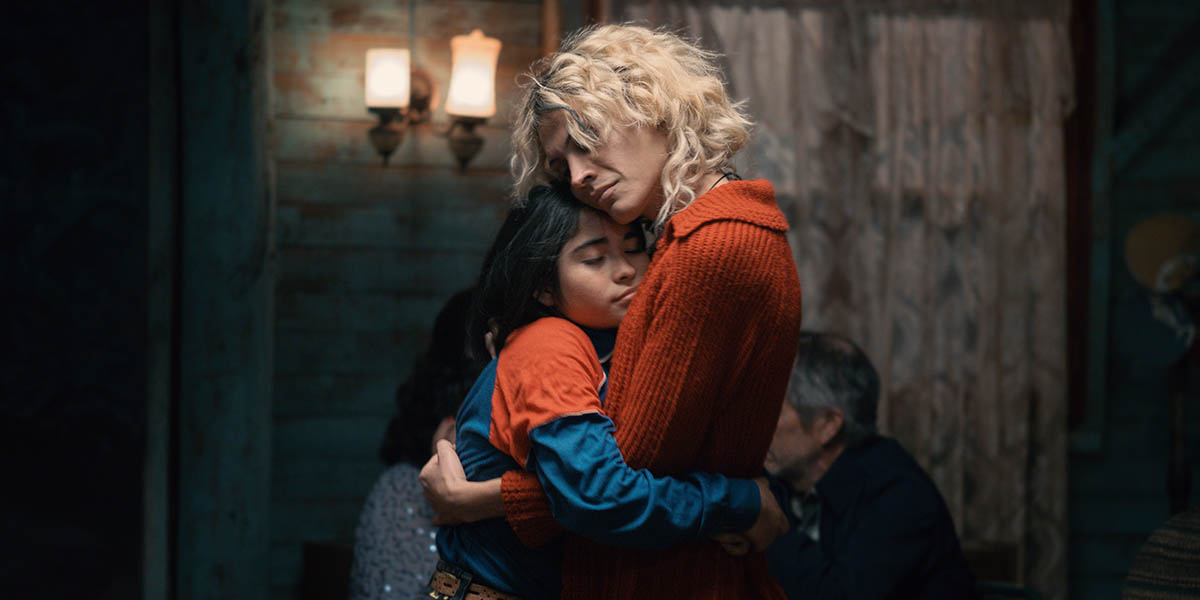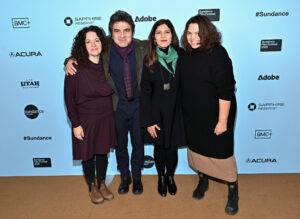By Jessica Herndon
When Chilean filmmakers Diego Céspedes and Giancarlo Nasi arrived at the Cannes Film Festival this past May, they brought with them a movie that was part fever dream, part social critique, and all heart. The Mysterious Gaze of the Flamingo, Céspedes’s debut feature, captivated the audience at Cannes, where it took home the Un Certain Regard Prize.
Set in a remote Chilean mining town in 1982, the film follows 11-year-old Lidia (played by breakout newcomer Tamara Cortés), who lives within a fierce, loving queer family. Looming over the area is a mysterious, deadly disease that is believed to transfer between two men through a sustained glance when they fall in love. As fear and violence plague the town, and locals start pointing fingers at Lidia’s kin, the young girl sets out to demystify the myth. A poetic and at times surreal modern western, Céspedes’s film is both brutal and beautiful.
The collaboration between Céspedes and Nasi on The Mysterious Gaze of the Flamingo has roots that stretch back to Sundance Institute, where both honed their craft as fellows in 2021 during our Feature Film Program — Céspedes in the Directors and Screenwriters Labs and Nasi in the Producers Lab. For Nasi, founder of the Chilean Film Academy, it wasn’t his first brush with the Institute; in 2016, the short Land of the Tides (Marea de Tierra), which he produced, premiered at the Sundance Film Festival in Park City, Utah.
Now, as The Mysterious Gaze of the Flamingo prepares for its U.S. release in early December, we speak with Céspedes and Nasi, who reflect on the journey from Sundance Institute Labs to Cannes and beyond, on creating a world where drag queens become warriors and children learn cruel lessons early, and on the impact of their film on their country.

Diego, what inspired you to write this story?
Diego Céspedes: Like a painting that you are doing for a long time, you bring different ideas from different places. For example, the characters are very similar to a lot of my close people. My siblings are a big inspiration for the personalities. About the topics, I’m very close to the history. I left my parents when I was a child and they had hairdressers in the suburbs — and all of the guys who worked there died of AIDS.
Your approach to love as a transmitter of disease is so striking, especially when you weave in surreal elements throughout the film. What was the impetus for this?
Céspedes: I remember that I read a book about the history of AIDS of Chile, and I remember one quote that said, “No one wants to look at the sick people in the eyes.” And the idea of the gaze and this myth started to be in my head. It was one of the ideas that brought the surreal parts or the mythological part and how people try to give a sense to what they don’t understand. That happens a lot in our country. We are a very isolated country because of the mountains. So, it’s a land of myths. It’s a thing that we all grew up with, unconsciously and consciously. So, that’s why the myth and the surreal part came to the movie, because it seems very natural.

The film is seen through the eyes of an 11-year-old girl. Why did you want to tell the story from her point of view and how did you approach balancing her innocence with these heavy themes of disease and social prejudice?
Céspedes: I think that you said it in the question: it’s about the innocence the eyes of a child has. When you tell the story with those eyes, it means that it has less prejudices because they didn’t go through the dark, adult world. Her feelings are, in a way, more pure because she wasn’t exposed to all this hate that mostly all of the girls living in the canteen had before they were living there. She has this purest soul, even if she has the personality of an adult because she grew up with the people that she grew up with.
How did you find Tamara Cortés, the incredible young actor who plays Lidia?
Céspedes: I wrote [that role] with this ironic, very straightforward personality with a strong gaze. I remember that it was the personality of all my siblings and all my cousins, and I wanted this kind of girl. It was so special. When we were doing the casting, Tamara was there, and she was exactly what I imagined. And she was so, so funny. We started a long process with her because she’d never acted before. We started with a coach and with me. She was a total professional. I’m very proud of her.

I want to also talk about your shooting locations. Why did you choose to film in the Atacama Desert and what were the beauties and challenges of filming there?
Nasi: We wanted to shoot in extreme natural places. I feel it’s something that is really in our DNA and in our imagination. For the town that you can see in the film, we took an old mining town that was mostly destroyed, and it was a ghost town, but it was an historical place, and we rebuilt it. And now it’s an historical place where we even have a plaque with the name of the film.
But filming was very challenging. It’s extremely far away. You’re very, very isolated. Every time you need to go from the hotel to the location set, it’s definitely more than an hour, two hours. But I feel like the most beautiful thing is that first of all, you’re in a magical place. Second of all, you start seeing how the people there react to the fact there’s a movie being shot near their houses, where not a lot of things happen. And then the film exploded in Cannes, and in Chile it became a big thing. There’s a lot of press around the film, and these people are very surprised. They were not expecting this to happen a year later. I think that’s beautiful. You make real people closer to the film world. Sometimes, we take things for granted, but for them it’s a dream. It’s been beautiful.

Let’s talk about Cannes! How did it feel to win the Un Certain Regard Prize at the festival?
Nasi: It was beautiful. We were programmed at the very beginning of the festival, which was very good. And people started talking a lot about the movie. People were stopping our actresses in the street saying, “Oh my God, you’re Boa, you’re Tamara. I love the film.” So the buzz was clear. And then we started getting a lot of great reviews, like The Hollywood Reporter saying it was the hidden gem in Cannes. And then suddenly we saw some traction. And then the moment arrives when they call you and say you need to go to the awards ceremony. That’s all they say. So we didn’t think we were going to get the best movie award. That moment was insane. And that whole night was beautiful. We talked with so many people that we admire.
Céspedes: Yes, I think that night was when Giancarlo became friends with Kristen Stewart. Giancarlo is her bestie now.
Nasi: I wish. I wish. It’s crazy because at the dinner you start realizing that you are the fan of [who] you are fans [of]. And then the next day we saw the reaction in Chile. And in Chile it was like we won the fucking World Cup! It was crazy. People were super excited. And then you start realizing that you made history. That it’s one of the biggest awards in the Chilean film industry and you realize how an entire country just comes together and cheers for you.
Congratulations! That’s so incredible. So, I want to go back a bit and discuss the origins of your film. Diego and Giancarlo, you began to piece The Mysterious Gaze of the Flamingo together when you participated in our labs. How did those experiences help shape this film?
Céspedes: Well, I remember that I had several meetings, but I met Walter Salles and I met Ira Sachs. I think that a good mentor doesn’t tell you what to do. They just trust your vision and improve it in its own way. I think that I had cool and very deep conversations about cinema with them. They supported my vision a lot. I don’t know if I changed a big part of the script, but I really trusted the script and the idea. That was a fundamental part.
Nasi: Walter Salles made a film that was very, very important in the entire Latin America and that everyone watched in Chile. So, for someone with that trajectory and from someone with that impact on popular culture, to be able to be so generous and not tell Diego what to do, but boost his vision and his confidence made him shine even more. That’s the way it should be. It’s a community that really serves the director’s vision.
I think that all the labs and residencies are fundamental. They allow diversity to come to our industry in a big way. If you don’t have the money, space, and people who trust you will develop, it will be the same people that make cinema. The labs, mentorships, and the support of the Sundance Film Festival allows the diversity from all over the world to come and to tell different stories — to go deeper into society — because you are not telling the story just from one side of the world.
That happened before the existence of all these residences and labs. It was very difficult for people from my social class or from different parts of the world to do cinema, to be a director, to be a writer. But with this time and the support, you can build new stuff, you can show new visions, you enrich the panorama of the cinema. Sundance really cares about being diverse and bringing different visions like nobody else.








